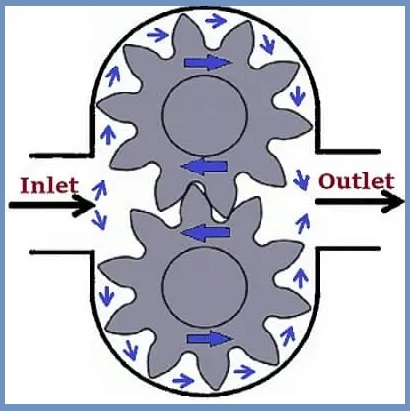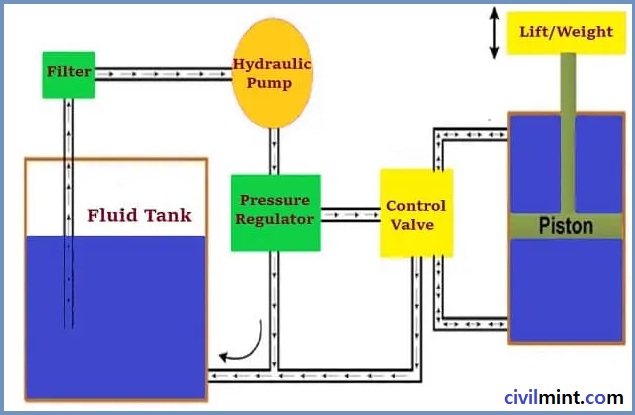A hydraulic pump is a device that converts the mechanical energy of hydraulic fluid into hydraulic power (hydraulic power such as pressure and flow). This pump generates a flow with sufficient capacity to overcome the pressure exerted by the load.
Hydraulic pumps are designed to supply hydraulic oil through the hydraulic system. It acts as the heartbeat of the system. All hydraulic pumps perform two main functions.
- These pumps supply hydraulic flow to other parts of the hydraulic system (eg hydraulic cylinders, jacks, hydraulic motors, etc.).
- They create a flow that creates additional pressure to overcome the flow resistance.
A hydraulic pump is a type of positive displacement pump used to deliver fluid. It is used to supply hydraulic oil to various parts of the system such as motors, hydraulic cylinders, and cylinders. In positive displacement pumps, the main purpose of the hydraulic pump is to supply hydraulic oil to the piston so that it can move forward and backward quickly. The power steering pump in an automobile is an example of a hydraulic pump. Another common example is an engine transmission oil pump.
In addition, the largest hydraulic pumps are driven by an electric motor and include a relief valve to prevent the overpressure of the pump. These pumps are primarily used for high flow and low-pressure applications. This is because it makes low-pressure fluids move at a higher speed and pumps large volumes of fluids in a short amount of time.
Table of Contents
Concept of Hydraulic System
A hydraulic system is a transmission technology that uses a fluid to transmit power from an electric motor to an actuator, such as a hydraulic cylinder. This fluid is incompressible and its path is as flexible as a wire.
These systems are mainly used when high power density is required or when the demand on the load increases rapidly. Hydraulic systems are particularly applicable to all types of mobile equipment and industrial systems.
In wind turbines, hydraulic systems are used to control tilt and brakes. In some cases, various auxiliary structures are also hydraulically driven.
Working Principle of Hydraulic Pump
Hydraulic pumps operate on the basic principle of displacement. Hydraulic pumps work in several stages.

Hydraulic pumps have two gears: drive or power and drive or intermediate. These gears fit each other. An electric motor is used to power the drive gear through the drive shaft. When the drive gear starts to rotate, the driven gear also rotates with that movement. The movement of these gears creates a vacuum at the inlet. This vacuum causes the pump to draw liquid or oil from the tank or reservoir.
The suction and discharge ports of the pump have check valves. The main purpose of the test is to prevent the backflow of the fluid. This pump draws liquid from the suction side and a check valve on the suction side helps to push the liquid into the pump. When the liquid pressure inside the pump is higher than the external liquid pump, the suction valve closes.
Since this fluid has no direct path to the drain valve, it must pass between the pump gears before it is drained. After entering the pump, the liquid is trapped between the driven gear and the driven gear.
This fluid or oil moves with the gears. As the fluid passes between the gears, the volume of the fluid decreases, and the flow rate increases. When the desired flow rate is reached, this hydraulic oil or fluid is discharged through an exhaust valve and fed to various parts of the system such as pistons and cylinders.
Components of a Hydraulic System
In extreme cases, hydraulic pumps are used to move fluids from low pressure to high pressure. Hydraulic systems are made up of several moving and static components. The main components of a hydraulic system are:
- Casing
- Runner Vanes
- Shaft
- Bearings
- Sealing
- Oil storage tank
- Pipeline
- Electric Motor
- Hydraulic drive
- Relief valve
I also attached an image to better understand all components of a Hydraulic System.

Various Types of Hydraulic Pump
- Rotary Vane pump
- External Gear Pump
- Lobe Pump
- Screw Gear Pump
- Vane Pumps
- Internal Gear Pump
- Piston pumps
- Axial Piston Pumps
- Radial Piston Pump
- Clutch Hydraulic Pump
- PTO Hydraulic Pump